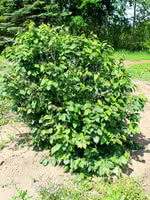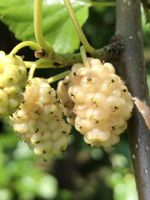Mon-Fri 9am - 5pm Mountain time
Cart reopens in November
Subscribe to our email list
to stay updated
Beaked Hazelnut vs Russian White Mulberry
Corylus cornuta
Morus alba tatarica
NOT AVAILABLE THIS SEASON
NOT AVAILABLE THIS SEASON
Beaked Hazelnut is a multi-stemmed, deciduous shrub native to North America.
It features smooth, grey bark and edible nuts. Beaked Hazelnut prefers a rich sandy-clay loam but will grow on poorer sites, and can be used as an understory shrub.
Note: You want more than one hazelnut to improve yields.
Russian White Mulberry is a cold hardy and adaptable tree. It is a great choice for the impatient gardener as it reaches its mature height in a short period of time and has an attractive, dense, and rounded form.
Odd looking berries are produced among a backdrop of glossy, deep green foliage. The blackberry-esque berries ripen slowly over the season, ranging in color from white, pink, and purple-violet. While the berries are not well regarded for fresh eating, they have made tasty jams and preserves.

